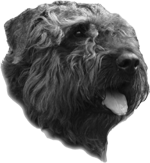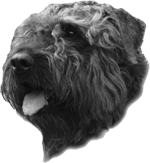|
![[In aanbouw]](../images/undercon.gif)





/_derived/First%20Aid.htm_cmp_kopie-van-kwadrant010_vbtn.gif)

| |
BOUVIER DES FLANDERS - FLANDERS COW DOG
Fédération Cynologique Internationale
Cecrétariat Général: 13, Place Albert 1 - B 6530 Thuin (Belg.)
FCI -
Standard N° 191/ 27.09.2002 / GB
TRANSLATION : Mrs.Jeans-Brown. Revised by Dr.R Pollet, with the collaboration
of R. Triquet and John Miller.
ORIGIN: Belgium-France
DATE OF PUBLICATION OF THE ORIGINAL VALID STANDARD : 22.06.2001
UTILIZATION : Originally the Bouvier des Flandres was used as a herding
dog, as a draught dog and as churning dog. The modernisation of farm equipment
has affected these first tasks and nowadays the Bouvier des Flandres is above
all used as a guard dog for the estate and the farm, as a defence and police
dog. Its physical and behavioural aptitudes, its great qualities of scent,
initiative and intelligence warrant it as a tracking dog, a messenger dog and a
gamekeeper's dog.
CLASSIFICATION F.C.I. : Group 1 Sheepdogs and Cattle dogs
(
except Swiss Cattle dogs ).
Section 2 Cattle
dogs ( exept Swiss Cattle dogs )
With working trail.
BRIEF HISTORICAL SUMMARY : As its name indicates, the Bouvier des
Flandres ( Flanders Cattle Dog ) is native to Flanders, to both Belgian and
French regions of that name, since they are not divided by any natural
frontiers. The cowmen and drovers of stock in Flanders needing good dogs to
drive their herds, only selected from the local dogs available those specimens
which possessed the required physical and behvioural qualities. The present day
Bouvier des Flandres has inherited these qualities.
GENERAL APPEARANCE : Sub-brachymorphic. Short and compact body gives
the impression of power, but without clumsiness. The Bouvier des Flandres is to
be judged in its natural stance, without physical contact with the handler.
IMPORTANT PROPORTIONS:
*Length of body from point of shoulder to point of buttock should be
approximately equal to height at withers,
* Proportions of length of skull to length of muzzle are 3 to 2.
BEHAVIOUR / TEMPERAMENT : The Bouvier des Flandres has the calm,
thoughtful character of a sensible, but fearless dog. Its lively look indicates
intelligence, energy and audacity. It is essential that the Bouvier des Flandres
should retain its aptitude for work. Any change which could harm this must be
penalised.
HEAD : The head has a massive appearance, still more accentuated by the
beard and moustache. It is in proportion to the body and stature. Its clean cut
lines are obvious to the touch.
CRANIAL REGION: Well-developed and flat, slightly less broad than long.
Toplines of skull and muzzle are parallel. Frontal groove hardly denoted.
Stop: Only slightly pronounced; more apparent than real, due to
upstanding eyebrows.
FACIAL REGION:
Nose: Nose continues the muzzle in a line which is slightly convex
towards its end. It must be well-developed, rounded at the sides and always
black in colour. Wide-open nostrils.
Muzzle: Broad, powerful, well-boned, straight in its upper line,
narrowing towards the nose, but never becoming pointed. Its length should be
shorter than the skull by 2 : 3 Circumference measured just below the eyes
should be approximately equal to length of head.
Lips: Well-fitting and strongly pigmented.
Jaws/Teeth: Jaws must be powerful and of equal length. Teeth are strong,
healthy, white and evenly set. Scissor or pincer bite. Dentition must be
complete.
Cheeks: Flat and clean, zygomatic arches are not very protruding.
Eyes: Frank and energetic expression, neither protruding nor sunken. They
should be slightly oval in shape, set horizontally. Colour should be as dark as
possible in relation to coat. Light and wild-looking eyes should be strongly
penalised Lids black, without the slightest indication of unpigmented areas. Haw
should never be visible.
Ears: Cropped in triangle, carried upright, set high, very mobile; a
crop proportioned to the head size is recommended.
Un-cropped ears:
Position: Set high, above eye level, flaps falling vertically. The fold must
not stand higher than the top of the skull.
Shape and carriage: Half-long, forming an equilateral triangle, slightly
rounded at tip, lying flat against cheeks, except the slight liftup at top of
ear set; neither folded nor curled, in proportion with head size; covered with
very short hair.
NECK: Should spring cleanly from the shoulders and is carried
sufficiently upright. Strong, well muscled, widening gradually towards the
shoulders. Lenght slightly shorter than length of head. Nape powerful and
slightly arched. No dewlap.
BODY: Powerful, close-coupled and short.
Topline: Upper line of back and loins horizontal, tight and firm
Withers: Slightly raised.
Back: Short, broad, muscled and well-supported, with no sign of weakness,
yet remaining flexible
Loins: short,broad, well muscled; must be flexible, with no sign of
weakness.
Croup: Must follow as closely as possible the horizontal line of the back
and blend imperceptibly into the curve of the buttocks. Broad but not
excessively so in males, more developed in bitches. A croup which falls away or
a goose rump is a serious fault.
Chest: Broad and well let down as far as level of elbows, but not
cylindrical. The first ribs are slightly arched, the others rounded and
well-sloped to the rear, giving the desired length of chest. Flat ribs to be
severely penalised. The distance from the point of the breast-bone ( manubrium )
to the last rib must be considerable, about 7/10 of the height at the withers.
Underline: The underside of the chest rises very slightly towards the
belly, which is only slightly tucked up. Flanks must be short, especially in
males.
TAIL: Set relatively high, the tail must continue the line of the
backbone. Some dogs are born tailless and must not be penalised for this. The
tail should be docked in the first week of birth leaving 2 or 3 vertebrae. In
countries where docking is banned, the whole tail is admitted
LIMBS :
FOREQUATERS:
Overview: Front legs have strong bone and are well-muscled. Perfectly
straight and parallel seen from the front.
Shoulders: Relatively long, muscled, wihout being heavy, modeately
oblique. Shoulder blade and humerus are
approximately of the same lenght.
Upper arm: Moderately oblique.
Elbows: Close to body and parallel. Elbows turning in or out, in a
natural stace or on the move, are considered a fault.
Forearm: Whether seen in profile or from the front, they must be
perfectly straight, parallel to each other and perpendicular to the ground. They
must be well-muscled and with good bone.
Wrist ( carpus ): Exactly in line with forearm. Only thepisiform bone just out
at the back of the wrist. Strong bone.
Front pasterns (metacarpus ) : Strong bone, quite short, sloping forward very
slightly.
Forefeet: Short, round, compact, neither toeing in nor toeing out. Toes
should be tight and arched, with strong and dark nails. Thick and hard pads.
HINDQUARTERS:
Overview: Strong, with pronouced muscle, upright and perfectly parallel
seen from the rear. Must move in the same planes as the front legs.
Upper thighs: Broad, well-muscled, parallel in direction to the median
plane of the body. Fermur must be neither too straight nor too sloping. Buttocks
well let down, trousered and firm.
Stifle (Knee): Set approximately on an imaginary straight line from the
highest point of the hip ( iliac crest ) perpendicular to the ground.
Lower thinghs: Moderately long, well-muscled, neither too straight nor
too sloping.
Hocks: Rather close to the ground, broad, tight. Seen from behind they
should be straight and perfectly parallel when standing. On the move they should
turn neither in nor out.
Rear pasterns ( metatarsus ): Strong and lean rather cylindrical, perpendicular
to the ground when the dog is in a natural standing position. No dewclaws.
Hind feet: Round, solid, toes tight and arched, with strong black nails.
Thick hard pads.
GAIT/MOVEMENT: The whole of the Bouvier des Flandres must be harmoniously
proportioned to ensure free, true and proud movement. Walking and trotting are
the normal gaits, although one does also encounter amblers. At a normal trot the
Bouvier des Flandres covers its traces i.e. covers the front pad marks with the
rear.
SKIN: Tight fitting; no excessive slackness; the edges of the eyelids
and lips are always very dark.
COAT:
Hair: The coat is very abundant, the outercoat forming with the dense undercoat
a protective layer perfectly adapted to the sudden climatic changes in this
breed's native land. The hair must be coarse to the touch, dry and matt, neither
too long nor too short ( about 6 cm. ), slightly tousled but never woolly or
curly. Shorter on the head and very short on the outside of the hair. The upper
lip carries a moustache and the chin a full beard, giving the forbidding
expression so typical of this breed. The eyebrows consist of raised hairs,
accentuating the shape of the superciliary ridges without ever veiling the eyes
The coat is particularly harsh and rasping on the upper part of the back. It
shortens very slightly on the limbs but remains harsh. A flat coat should be
avoided because it denotes a lack of undercoat. The undercoat is a padding made
up of dense hair which grows beneath the outer coat and together with the
topcoat it forms a waterproof covering.
COLOUR:
The Bouvier des Flandres ' coat is usually grey, brindle or overlaid with black.
A completely uniform black is also accepted, without being favoured.
Light-coloured, so-called washed-out coats are not acceptable. A white star on
the chest is tolerated.
SIZE AND WEIGHT:
Height at the withers : 62 to 68 cm for males
59 to 65 cm for females
With a tolerance of plus or minus 1 cm For both sexes, the ideal size is the
middle range, i.e. 65 cm for males 62 cm for females.
Weight: approximately 35 - 40 kg for males
27 - 35 kg for females
FAULTS : Any departure from the foregoing points should be considered a
fault and the seriousness with which the fault should be regarded should be in
exact proportion to its degree.
SERIOUS FAULTS;
· Timid dog
· Molossoïd appearance, too heavy a dog
· Body obviously too long (slight tolerance for females), or
. too light
· Too massive a head, marked stop, pronounced, frontal groove, . . very
prominent zygomatic arches
· Domed skull, narrow skull, very prominent occipital crest, important lack of
parallelism between the toplines of skull and muzzle
· Muzzle too long, pinched nose
· Loose, thick or overlapping lips
· Wry jaw; malocclusion
· Small, unhealthy or poorly set teeth
· Light eyes, bulging eyes, utypical expression
· Uncropped ears, which are curled or folded
· Cylindrical neck, dewlap
· Back very sagging, very arched.
· Very faulty stance, obviously camped stance, sickle hocks
· Silky coat, lack of undercoat, puffed up coat, shiny,overgroomed.
· Lack of head furnishings.
· Simultaneous faults in pigmentation (nose, lips, eyelids)
ELIMINATING FAULTS:
· Overly shy or dangerously aggressive dog
· Obvious lack of type
· Unpigmented nose or of any color other than black
· Pointed muzzle.
· Pronounced over - or undershot bite.
· Any missing teeth, other than P1.
· Wall eyes or wild expression
· Entropion, Ectropion, unpigmented eyelids
· Coat chocolate brown, white, pepper and salt, washed-out colour and any
other pale fawn going from light to red, even with black overlay
· Height at the withers outside range of the standard
N.B.: Male animal should have two apparently normal testicles fully decended
into the scrotum.
|




